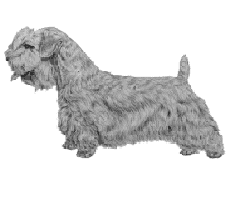Sealyham Terrier
General Information - Sealyham Terrier

Group:
Terrier
Size:
medium
Lifespan:
11-13 years
Exercise:
low
Grooming:
moderate
Trainability:
very hard
Watchdog ability:
high
Protection ability:
low
Area of Origin:
Wales
Date of Origin:
1800’s
Other Names:
none
Original Function:
Badger, otter, and
fox hunting
History
Although some evidence exists of a small, white, long-backed terrier imported into Wales in the 15th century, the documented history of the Sealyham begins only in the mid-1800s. The only reason the earlier observation receives some credence is that the originator of the breed, Capt. John Edwardes of Sealyham, was a descendant of the family said to have imported the particular dog centuries earlier. Regardless, Capt. Edwardes worked from 1850 to 1891 to develop the breed now known as the Sealyham Terrier. Through crossing hounds, the Dandie Dinmont, the Basset of Flanders, the Corgi, the West Highland Terrier, and the Wirehaired Fox Terrier the dog we know today was created.
Temperament
Sealyhams are loyal, loving, independent, spirited, and affectionate. They are brave little dogs. It has been descried as "the most beautiful union between cheerfulness and courage." Sealyhams are not as rowdy as some of the other terrier breeds. They are somewhat reserved with strangers, fairly independent, and generally good with other pets, although they can get very dog-aggressive. Sealyhams like to bark. They are a little difficult to train but they can hunt, track and are good watchdogs. Sealyhams are good at catching mice and rats. They are best with older children who are considerate of dogs. Sealyhams are "pack" dogs. They appreciate being a key part of a family and welcome companionship with other dogs.
Upkeep
The Sealyham's exercise needs are not too demanding, consisting of a short to moderate walk or game session every day. If allowed off leash, it should be in a safe area because it may tend to follow its nose. This breed is suited for indoor life, preferably with yard access, although it can live in an apartment. Its wire coat needs combing two to three times weekly, plus shaping every three months. Shaping for pets is by clipping and for show dogs by stripping.
Sealyham Terrier
A breed standard is the guideline which describes the ideal characteristics, temperament, and appearance of a breed and ensures that the breed is fit for function with soundness essential. Breeders and judges should at all times be careful to avoid obvious conditions and exaggerations, as well as being mindful of features which could be detrimental in any way to the health, welfare or soundness of this breed.
Breed Standard - Sealyham Terrier
 Characteristics
Characteristics: Alert and fearless but of friendly disposition.
General Appearance: Should be that of a freely moving and active dog, presenting a balanced picture of great substance in a small compass. General outline oblong, not square.
Head and Skull: The skull slightly domed and wide between the ears. Cheek bones should not be prominent. Punishing square jaw, powerful and long. Nose black.
Eyes: Dark, deep set, oval but not small. Unpigmented eye rims permissible.
Ears: Size medium, slightly rounded at tip and carried at side of cheek.
Mouth: Teeth level and strong, with canine teeth fitting well into each other and long for the size of the dog. A scissor bite is preferred - viz the jaws should be strong, with a perfect, regular and complete scissor bite,
i.e. the upper teeth closely overlapping the lower teeth and set square to the jaws. A level bite is permissible.
Neck: Fairly long, thick and muscular, on well:laid shoulders.
Forequarters: Forelegs should be short, strong and as straight as possible consistent with the chest being well let down. Point of shoulder should be in line with point of elbow which should be close to side of chest.
Body: Medium length, level and flexible with ribs well sprung. Chest broad and deep, well let down between forelegs.
Hindquarters: Notably powerful for size of dog. Thighs deep and muscular with well bent stifle. Hocks strong, well bent and parallel to each other.
Feet: Round and catlike with thick pads. Feet pointing directly forward.
Gait: Brisk and vigorous with plenty of drive.
Tail: Customarily docked. Set in line with back and carried erect. Quarters should protrude beyond set of tail.
Coat: Long, hard and wiry topcoat with weather resistant undercoat.
Colour: All white, or white with lemon, brown or badger pied markings on head and ears. Much black and heavy ticking undesirable.
Weight and Size: Ideal weight - dogs about 9 kg (20 lb); bitches about 8.1 kg (18 lb).
Height should not exceed 30.4 cm (12 in) at the shoulder.
General conformation, overall balance, type and substance are the main criteria.
Faults: Any departure from the foregoing points should be considered a fault and the seriousness with which the fault should be regarded should be in exact proportion to its degree.
Note: Male animals should have two apparently normal testicles fully descended into the scrotum.
DNZ No 272
Copyright Dogs New Zealand
23 Dec 2013
Any departure from the foregoing points should be considered a fault and the seriousness with which the fault should be regarded should be in exact proportion to its degree and its effect upon the health and welfare of the dog and on the dog’s ability to perform its traditional work.




